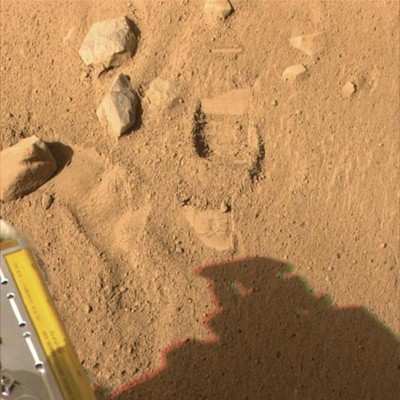Soil Data Suggests Liquid Past
NASA's Phoenix Mars Lander has detected snow falling from
Martian clouds. Spacecraft soil experiments also have provided
evidence of past interaction between minerals and liquid water,
processes that occur on Earth.

A laser instrument designed to gather knowledge of how the
atmosphere and surface interact on Mars has detected snow from
clouds about 4 kilometers (2.5 miles) above the spacecraft's
landing site. Data show the snow vaporizing before reaching the
ground.
"Nothing like this view has ever been seen on Mars," said Jim
Whiteway, of York University, Toronto, lead scientist for the
Canadian-supplied Meteorological Station on Phoenix. "We'll be
looking for signs that the snow may even reach the ground."
Phoenix experiments also yielded clues pointing to calcium
carbonate, the main composition of chalk, and particles that could
be clay. Most carbonates and clays on Earth form only in the
presence of liquid water.
"We are still collecting data and have lots of analysis ahead,
but we are making good progress on the big questions we set out for
ourselves," said Phoenix Principal Investigator Peter Smith of the
University of Arizona, Tucson.
Since landing on May 25, Phoenix already has confirmed that a
hard subsurface layer at its far-northern site contains water-ice.
Determining whether that ice ever thaws would help answer whether
the environment there has been favorable for life, a key aim of the
mission.
The evidence for calcium carbonate in soil samples from trenches
dug by the Phoenix robotic arm comes from two laboratory
instruments called the Thermal and Evolved Gas Analyzer, or TEGA,
and the wet chemistry laboratory of the Microscopy,
Electrochemistry and Conductivity Analyzer, or MECA.
"We have found carbonate," said William Boynton of the
University of Arizona, lead scientist for the TEGA. "This points
toward episodes of interaction with water in the past."
The TEGA evidence for calcium carbonate came from a
high-temperature release of carbon dioxide from soil samples. The
temperature of the release matches a temperature known to decompose
calcium carbonate and release carbon dioxide gas, which was
identified by the instrument's mass spectrometer.
The MECA evidence came from a buffering effect characteristic of
calcium carbonate assessed in wet chemistry analysis of the soil.
The measured concentration of calcium was exactly what would be
expected for a solution buffered by calcium carbonate.
Both TEGA, and the microscopy part of MECA, have turned up hints
of a clay-like substance. "We are seeing smooth-surfaced, platy
particles with the atomic-force microscope, not inconsistent with
the appearance of clay particles," said Michael Hecht, MECA lead
scientist at NASA's Jet Propulsion Laboratory in Pasadena, CA.
The Phoenix mission, originally planned for three months on
Mars, now is in its fifth month. However, it faces a decline in
solar energy that is expected to curtail and then end the lander's
activities before the end of the year. Before power ceases, the
Phoenix team will attempt to activate a microphone on the lander to
possibly capture sounds on Mars.
"For nearly three months after landing, the sun never went below
the horizon at our landing site," said Barry Goldstein, JPL Phoenix
project manager. "Now it is gone for more than four hours each
night, and the output from our solar panels is dropping each week.
Before the end of October, there won't be enough energy to keep
using the robotic arm."

The Phoenix mission is led by Smith at the University of
Arizona. Project management is the responsibility of JPL with
development partnership by Lockheed Martin in Denver. International
contributions come from the Canadian Space Agency; the University
of Neuchatel, Switzerland; the universities of Copenhagen and
Aarhus, Denmark; Max Planck Institute, Germany; and the Finnish
Meteorological Institute.
 ANN's Daily Aero-Linx (04.15.24)
ANN's Daily Aero-Linx (04.15.24) Classic Aero-TV: 'No Other Options' -- The Israeli Air Force's Danny Shapira
Classic Aero-TV: 'No Other Options' -- The Israeli Air Force's Danny Shapira Aero-News: Quote of the Day (04.15.24)
Aero-News: Quote of the Day (04.15.24) Airborne 04.16.24: RV Update, Affordable Flying Expo, Diamond Lil
Airborne 04.16.24: RV Update, Affordable Flying Expo, Diamond Lil ANN's Daily Aero-Term (04.16.24): Chart Supplement US
ANN's Daily Aero-Term (04.16.24): Chart Supplement US




